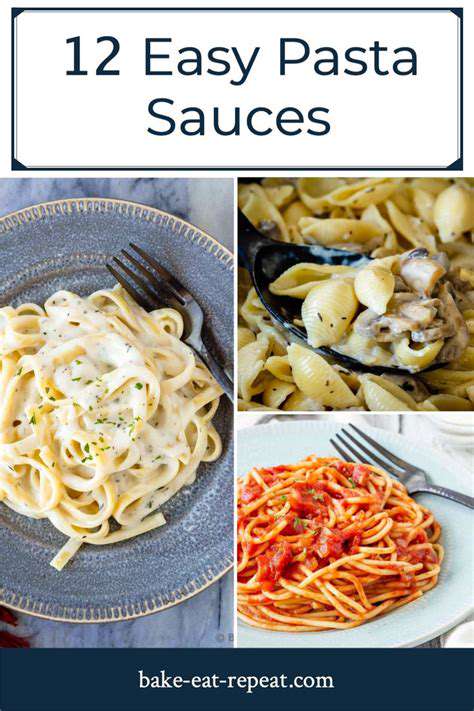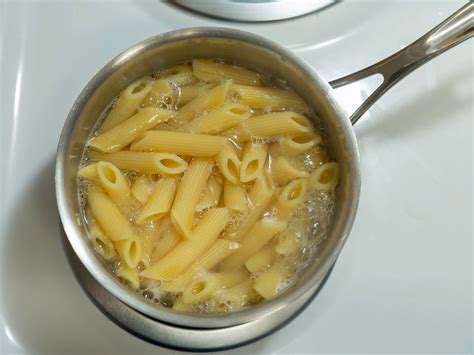Simple Pasta Dishes: Weeknight Wonders
Quick Creamy Tomato Pasta
There's something magical about tossing everything into a single pot and ending up with a meal that tastes like it took hours to prepare. This creamy tomato pasta is a perfect example. Start by softening diced onions and garlic in olive oil—just until they release their aroma. Then, stir in crushed tomatoes and a splash of cream (or milk for a lighter version). The real secret lies in cooking the pasta directly in the sauce, allowing the starches to create a luxuriously thick texture. Finish with fresh basil and Parmesan for a dish that feels indulgent yet comes together in under 30 minutes.
What makes this recipe special is how easily it adapts to whatever you have on hand. Toss in some wilted greens during the last few minutes of cooking, or add a handful of sun-dried tomatoes for extra depth. The possibilities are endless, making this a go-to for busy weeknights when you want something satisfying without the fuss.
Garlic Parmesan Pasta Perfection
Sometimes the simplest combinations create the most memorable meals. This garlic Parmesan pasta proves that point beautifully. The technique couldn't be easier: sauté minced garlic in butter until golden, then toss with al dente pasta and generous amounts of freshly grated Parmesan. The key is using real Parmigiano-Reggiano—its nutty complexity elevates the entire dish. A splash of pasta water helps create a silky sauce that clings to every strand.
What makes this version stand out is the attention to timing. Adding the cheese off the heat prevents clumping, while the reserved starchy water transforms what could be a dry mess into a creamy masterpiece. Serve immediately with extra black pepper for a dish that's comforting yet sophisticated enough for company.
Lemon-Herb Pasta Symphony
When you're craving something bright and fresh, this lemon-herb combination delivers. The method is straightforward but requires precision: gently warm chopped herbs (parsley, thyme, and oregano work beautifully) in olive oil to release their essential oils before adding lemon zest and juice. The trick is balancing the acidity—too much lemon overwhelms, while too little misses the point. Toss with hot pasta and finish with a final squeeze of lemon for a dish that tastes like sunshine.
One-Pot Pesto Pasta Delight
Pesto transforms ordinary pasta into something extraordinary, and doing it all in one pot makes the process effortless. The method here is crucial: sauté garlic briefly (just until fragrant), then add pasta and enough water to cook it. Adding the pesto at the very end preserves its vibrant color and fresh flavor. The starchy pasta water helps emulsify the sauce, creating a creamy consistency without any dairy. Toasted pine nuts add crunch, while extra Parmesan brings richness.
This version stands out because it respects the delicate nature of fresh basil. Unlike methods that cook the pesto, this technique keeps the sauce bright and herbaceous. It's a perfect example of how minimal effort can yield maximum flavor when you understand ingredient interactions.
Simple Sauces to Elevate Your Pasta

Simple Vinaigrettes
The beauty of vinaigrettes lies in their simplicity and versatility. A basic ratio of three parts oil to one part acid creates a perfect foundation. The magic happens when you start experimenting with different vinegar varieties—sherry vinegar adds depth, while champagne vinegar brings lightness. Fresh herbs and a touch of Dijon mustard transform this simple emulsion into something extraordinary.
Creamy Sauces
Mastering a basic roux (equal parts butter and flour cooked briefly) opens up a world of creamy possibilities. The technique is simple but requires attention: cook the roux until it smells nutty but before it browns, then whisk in warm liquid gradually. This method prevents lumps and creates a velvety texture that's perfect for cheese sauces or mushroom gravies. The real artistry comes in choosing your flavorings—sharp cheddar for macaroni and cheese, or blue cheese for a sophisticated pasta sauce.
Honey Mustard
The perfect honey mustard balances sweet and tangy elements. Start with equal parts honey and Dijon mustard, then adjust to taste. A splash of apple cider vinegar brightens the flavors, while a pinch of salt rounds them out. This versatile sauce works equally well as a glaze for roasted chicken or a dressing for hearty grain bowls.
Garlic Aioli
Authentic aioli begins with a mortar and pestle—crushing garlic with salt releases essential oils that infuse the sauce. Using room temperature egg yolks and adding oil drop by drop initially ensures proper emulsification. Lemon juice adds brightness, while a touch of warm water can adjust the consistency. This labor of love results in a sauce with unparalleled depth of flavor.
Spicy Sriracha Mayo
The best spicy mayo balances heat with creaminess. Start with quality mayonnaise as a base, then add sriracha gradually until you reach the desired heat level. A squeeze of lime juice and a pinch of sugar create a more complex flavor profile. This condiment transforms ordinary sandwiches and burgers into something special.
Balsamic Glaze
Reducing balsamic vinegar concentrates its natural sweetness while mellowing its acidity. The key is slow reduction over low heat—rushing this process can result in a bitter taste. When the glaze coats the back of a spoon, it's ready. Drizzle over roasted vegetables or fresh strawberries for an instant flavor upgrade.
Simple Chimichurri
Authentic chimichurri relies on fresh herbs and proper chopping technique. Hand-chopping the parsley and oregano releases more flavor than food processor methods. The balance of olive oil to vinegar should be about 3:1, with enough garlic to give it punch but not overwhelm. This vibrant sauce brings grilled meats to life.
From Pantry to Plate: Mastering the Simple Pasta Recipe
Basic Ingredients for Success
Quality ingredients make all the difference in simple pasta dishes. While fresh pasta offers superior texture, high-quality dried varieties (look for bronze-die extruded shapes) provide excellent results. Salt your pasta water aggressively—it should taste like the sea—as this seasons the pasta from within. Good olive oil and fresh garlic form the foundation of countless delicious sauces.
Essential Cooking Techniques
Perfect pasta begins with proper boiling technique. Use at least 4 quarts of water per pound of pasta, and wait for a rolling boil before adding noodles. Stir frequently during the first minute to prevent sticking, then occasionally thereafter. Reserve a cup of starchy cooking water before draining—this liquid gold helps sauces cling to pasta beautifully.
Sauce Variations and Flavor Profiles
The simplest sauces often shine brightest. A classic aglio e olio (garlic and oil) demonstrates how few ingredients can create incredible depth when handled properly. The garlic should cook gently in olive oil until just golden—burnt garlic ruins the dish. Red pepper flakes add heat, while parsley brightens the flavor. Experimenting with different cheese varieties can completely transform a basic pasta dish.
Serving and Presentation Tips
Pasta continues cooking even after draining, so err on the side of underdone. Tossing the pasta with sauce in the warm pan allows flavors to meld perfectly. Serve immediately in warmed bowls, garnished appropriately—a dusting of cheese for rich sauces, or fresh herbs for lighter preparations. The right pasta shape for your sauce makes both visual and textural differences.
Pasta Perfection: Beyond the Basics

Elevating Your Pasta Game
Exceptional pasta dishes begin with understanding fundamentals. Temperature control separates good pasta from great—sauces should be ready when pasta is drained. Learning to balance flavors (salt, acid, fat, and heat) transforms simple ingredients into memorable meals. The best cooks taste constantly and adjust seasoning throughout the cooking process.
Exploring Diverse Sauces
Moving beyond tomato and cream opens exciting possibilities. Anchovy-based sauces offer umami depth, while walnut sauces provide earthy richness. Asian-inspired peanut sauces or Mexican mole can create unexpected but delicious fusion dishes. The key is balancing new flavors while respecting pasta's essential character.
The Importance of Fresh Ingredients
Seasonality dramatically impacts pasta dishes. Summer tomatoes make incomparable sauces, while autumn mushrooms add deep, woodsy notes. Fresh herbs should be added at the end to preserve their vibrancy. Farmers market finds often inspire the most memorable pasta creations.
Pasta Shapes and Their Roles
Shape matters more than many realize. Tube pastas like penne trap chunky sauces, while long strands showcase oil-based preparations. Ridged surfaces hold sauce better than smooth ones. Matching shape to sauce ensures every bite delivers balanced flavors and textures.
Perfecting the Cooking Technique
The difference between al dente and overcooked pasta is about 30 seconds. Testing pasta a minute before package directions suggests prevents mushiness. Proper draining (without rinsing) preserves surface starch that helps sauce adhere. These small details separate adequate pasta from extraordinary.
- Storing Potatoes: Prevent Sprouting
- Healthy Meal Prep for Weight Loss: 5 Days of Deliciousness
- Smart Food Storage: Keep Your Groceries Fresh Longer
- Exploring Italian Pasta Dishes: Beyond Spaghetti Bolognese
- Decadent Chocolate Chip Cookies: The Secret to Perfect Chewyness
- Cooking with Instant Pot Vortex: Air Fryer and More
- Quick Weeknight Meals: From Pantry to Plate
- Storing Rice and Grains: Pantry Best Practices
- Baking for Beginners: Easy Recipes to Master
- Instant Pot Basics: Quick & Easy Pressure Cooker Meals
- Discovering Brazilian Feijoada: A Hearty Stew